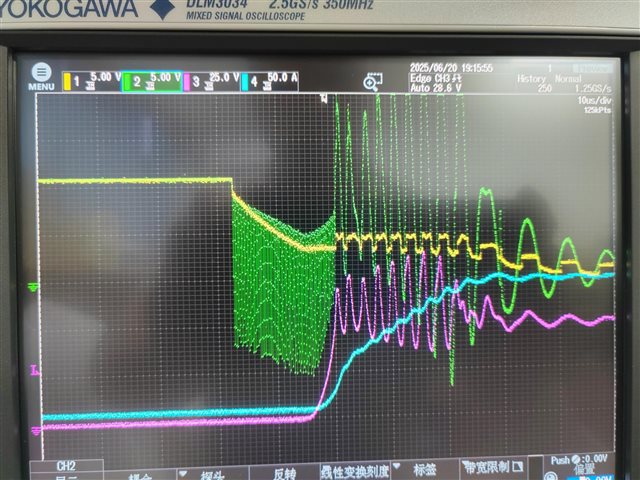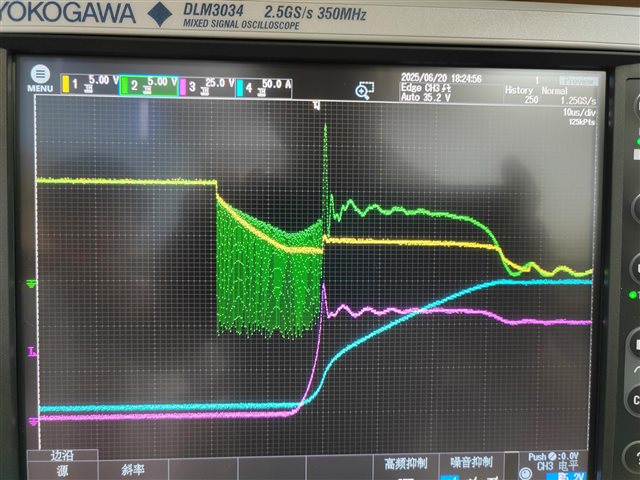

如上两张图片,黄色:放电MOS关Vgs,绿色:DSG引脚,红色:放电MOS管Vds,蓝色:PACK输出电流;
现象:两个版本的测试图片,左图是新版本,DSG引脚震荡,右图是旧版本,无次震荡;
问题:经过查找、对比原理图、PCB文件,没有找出差异,现在不清楚为什么DSG会震荡?需要协助查找原因以及解决办法
已经处理过的:通过对换MOS,已经明确确定是新版本的PCB或者原理图哪里有影响,旧版本的PCB没有问题, 并且PIN46-PIN47脚的电容电压是稳定的,没有发现震荡现象
This thread has been locked.
If you have a related question, please click the "Ask a related question" button in the top right corner. The newly created question will be automatically linked to this question.


如上两张图片,黄色:放电MOS关Vgs,绿色:DSG引脚,红色:放电MOS管Vds,蓝色:PACK输出电流;
现象:两个版本的测试图片,左图是新版本,DSG引脚震荡,右图是旧版本,无次震荡;
问题:经过查找、对比原理图、PCB文件,没有找出差异,现在不清楚为什么DSG会震荡?需要协助查找原因以及解决办法
已经处理过的:通过对换MOS,已经明确确定是新版本的PCB或者原理图哪里有影响,旧版本的PCB没有问题, 并且PIN46-PIN47脚的电容电压是稳定的,没有发现震荡现象
您好
初始振荡看起来可能是我们器件 DSG 引脚的 FET 驱动器关断的一部分。 我们的器件将首先开始向 VSS 对 DSG 引脚放电、但为了防止 DSG FET 栅极被驱动到显著低于 PACK+的水平、我们的器件会监测 LD 引脚电压、并在 DSG 引脚电压降至 LD 引脚电压以下时停止放电。 我们的器件会在一段时间内的一系列脉冲中多次执行此操作、以便将 DSG 栅极放电至 LD 引脚的电压。 数据表中的第16.5节 FET 驱动器关断和第8节来自多个 FET 的 DSG 驱动器应用手册进一步讨论了此行为并显示了此行为的波形。
如果波形显示的振荡超过~200us、则它与 FET 选择及其周围的电路更相关。 此 MOSFET 常见问题解答中的第4项可能会部分解释您在更换 FET 之前会看到额外振荡的原因。
Thank you very much for your reply; however, this did not eliminate my doubts.
1、We have two versions of the PCB board, V01 and V02. The V01 version is normal, as shown in the upper left picture. However, the Vds of the V02 version will oscillate severely. We swapped the two versions of the MOS FET, but the problem still couldn't be solved.
2、The high-frequency oscillation at the beginning of the DSG output pin is known to be an inherent phenomenon of this device. The main problem lies in the relatively small frequency fluctuations at the end, which is the culprit. We still haven't been able to pinpoint the cause.
3、We have checked the influence of the MOS field-effect transistor itself and the circuit connections. We also compared it with the previous PCB layout. So far, we still can't determine the cause. Please help analyze it. Your assistance is still needed for further investigation of the cause.
您好
已经处理过的:通过对换MOS,已经明确确定是新版本的PCB或者原理图哪里有影响,旧版本的PCB没有问题, 并且PIN46-PIN47脚的电容电压是稳定的,没有发现震荡现象
I'm a little confused now. The statement above here says that by changing the MOSFET, no oscillations were further observed.
The main problem lies in the relatively small frequency fluctuations at the end, which is the culprit. We still haven't been able to pinpoint the cause.
Do you mind sharing your schematic? Also, did the layout between PCB V01 and V02 change? If yes, what changed? Just the MOSFET selection?
It has been confirmed that the wiring of VC0 and CV1 on the PCB has not been altered at all. The attachment is our wiring diagram. Please kindly receive it.AFE_Protect.pdf
您好
After reviewing your schematic, I have these comments/questions below:
High Daniel,
Thanks for your reply.
We are now quite certain that the turn-off oscillation of MOS is too large, which is caused by PCBlayout. However, we haven't determined the exact reason yet. Could you give us some suggestions? What might have caused this peak? What improvements do we need to make?
您好
-I think it has the same function as R14. So, should this resistor be able to be removed here?
I think this should be fine to remove.
This parameter should be the one that needs to be adjusted, right? Don't shut it off too quickly, otherwise it should cause an excessive spike, is that correct? At the same time, I will also try to make some adjustments to see the effect.
Correct. Please let me know if any changes are seen.
In fact, no components were soldered at the position of D4. However, the function of R17 is quite obvious. It is mainly used for reverse charging to turn off the MOS.
Understood. Thank you for confirming that. From my understanding, R17 may not be needed, but it should be okay to keep.
I didn't understand this. Could you please describe it in more detail? What exactly do we need to do?
There wasn't anything necessarily needed to be done. I was more curious to know why there wasn't any resistors selected there is all (PCHG has RP3/RP4/RP2/RP1).
We are now quite certain that the turn-off oscillation of MOS is too large, which is caused by PCBlayout.
Do you know what differences there are between the two layouts?
Could you give us some suggestions? What might have caused this peak? What improvements do we need to make?
I will check with the team internally to see if they have anything they can also share.
High Daniel,
Thanks for your reply.
1、There wasn't anything necessarily needed to be done. I was more curious to know why there wasn't any resistors selected there is all (PCHG has RP3/RP4/RP2/RP1). ----We realize that we made a mistake here. We have already adjusted RP1/RP2/RP3/RP4 to the P+ position.
2. We have attempted to adjust R10 to 100Ω. This can accelerate the discharge speed of the MOS, especially in the case of short circuits, and can significantly reduce the turn-off loss. However, it cannot solve the Vds oscillation that occurs during the turn-off process.This still requires your team to analyze and determine what the possible reasons might be.
3. We have also encountered a new issue that requires your assistance. Under the condition of MCU reset (either by burning in the code or manually pulling down the RST pin of the MCU to make it stop functioning), the AFE will burn the equalization resistor. This has occurred three times consecutively. However, after spending an entire afternoon conducting repeated tests, I was unable to reproduce it. Could you please tell me what might be the cause of this?
Regarding the AFE damage, what we observed was that all the equalizers were turned on, and the drive resistors of the transistors, such as R70, and the voltage sampling resistors, such as R71, were all burned out. Through actual measurement, it was found that each voltage sampling port (such as VC1 ~ VC15) all output the same voltage as B+, and this was just a phenomenon that occurred during the operation of the MCU when it was being programmed.